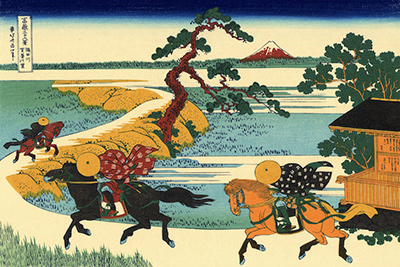Hokusai was primarily famous for his adeptness in regards to woodblock prints. Although he was indeed prolific, many feel that the height of his career began in 1798 when he began experimenting with a series of brush paintings referred to as surimono in Japanese.
It is nonetheless interesting to note that it would not be until later in his career when he would produce Barrier Town on the Sumida River. It is said that he was influenced by more traditionalist approaches and this could perhaps be a sign of his maturation as an artist. Unlike other works such as The Great Daruma, Barrier Town on the Sumida River utilises much more muted and organic tones. Browns, reds and light blues tend to dominate the piece and it is interesting that much of the background remains devoid of any tones. It is also thought that this approach may have been a result of his strong religious beliefs; particularly later in life. As witnessed in many of his other works, a view of Mount Fuji is clearly visible in the background.
Not only does this symbolise Japan as a whole, but it is representative of his strong Buddhist beliefs. The fact that the three characters displayed within the painting seem to be travelling toward the base of the mountain could be interpreted as his own desire to become closer to his own sense of spirituality. While not as famous as his other works, Barrier Town on the Sumida River is certainly representative of the sheer talent of this prolific painter.
Katsushika Hokusai was a well-known and prolific Japanese artist whose works stretched between the 18th and 19th centuries. Primarily respected for his woodblock prints, he also experimented with the use of vibrant colours and an ability to embrace the traditional artistic styles of his country. It can be argued that his most famous work was The Great Wave of Kanagawa (1829) although many other pieces have caught the attention of aficionados over the years. One example can be seen in a piece known as Barrier Town on the Sumida River (Sumidagawa Sekiya no sato in Japanese).




